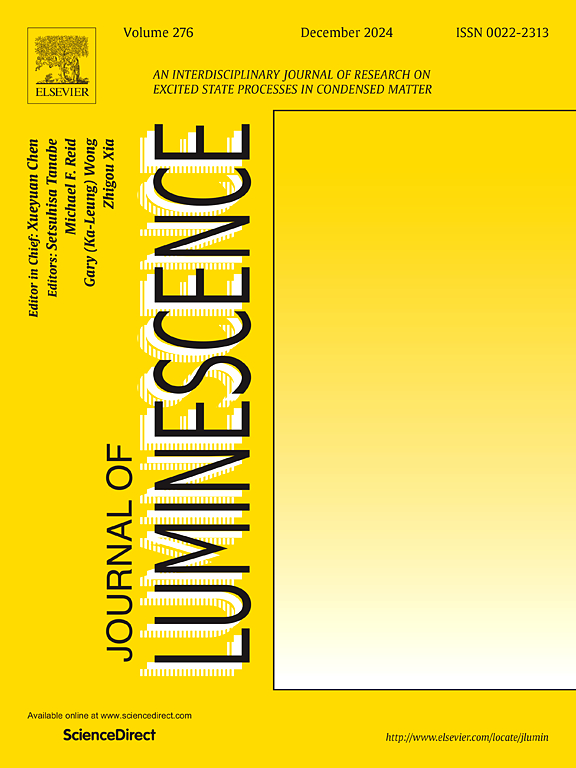The effect of Eu2O3 amount in the structural, optical, luminescence properties and covalent/ionic character bonding
IF 3.3
3区 物理与天体物理
Q2 OPTICS
引用次数: 0
Abstract
Phosphate glasses with composition 60P2O5 – 15ZnO - 5Al2O3 – 10BaO - 10PbO (mol%) (PZABP) and triple-doped with 1.2 Yb2O3, 0.2 Er2O3 and X Eu2O3 X = 0.0, 0.1, 0.5, 0.8 and 1.5 (wt%) were synthesized by the fusion method and their structural, optical and spectroscopic properties are reported. Experimental research was achieved to obtain information about the physical and chemical properties. The experiments indicate that the rare earth (RE3+) ions are incorporated in the structure of the glass, obtaining transparent, dense glasses, without cracks and with a homogeneous composition. The XRD reveals the amorphous nature of the glass samples. The ATR-FTIR and Raman scattering spectra were performed to study the structure of the glass and the bonds present in the PZABP matrices with RE3+ ions. The absorption and optical transmission spectra showed narrow bands attributed to Eu3+, resulting from the 5D0 →7FJ transitions (J = 0, 1, 2, 3 and 4) for the systems studied. The direct and indirect band intervals obtained by the Tauc method were determined. Urbach Energy, Optical Basicity, Optical Electronegativity and Refractive Index of the glasses were also calculated. The Judd-Ofelt model calculus was performed to analyze the spectroscopic parameters of Eu3+ ions, such as radiative lifetime, quantum efficiency, and local environment of the Eu3+ ion. The excitation and emission photoluminescence spectra were obtained to evaluate the influence of Eu3+ doping concentration on luminescence performance in the glass matrices. The covalence and ionic bonding have presented an interesting effect as a function of Eu2O3, based on the calculus performed by the Duffy equation. The mean lifetime values of the excited state ranged from 2.31 to 2.14 ms. Based on the results, these glasses may be potential candidates for the construction of different devices in the photonics area such as energy converters in the UV range and/or filters for UV wavelength.
研究了Eu2O3用量对结构、光学、发光性能和共价/离子键合特性的影响
采用熔合法制备了60P2O5 - 15ZnO - 5Al2O3 - 10BaO - 10PbO (mol%) (PZABP)和三掺杂1.2 Yb2O3、0.2 Er2O3和X Eu2O3 X = 0.0、0.1、0.5、0.8和1.5 (wt%)的磷酸玻璃,并报道了其结构、光学和光谱性能。通过实验研究,获得了其理化性质的相关信息。实验表明,稀土(RE3+)离子被引入到玻璃的结构中,得到了透明、致密、无裂纹、成分均匀的玻璃。XRD显示了玻璃样品的无定形性质。利用ATR-FTIR和拉曼散射光谱研究了玻璃的结构和RE3+离子在PZABP基体中的键。系统的5D0→7FJ跃迁(J = 0、1、2、3和4)导致了Eu3+的窄带吸收和透射光谱。确定了tac法得到的直接和间接带间隔。计算了玻璃的乌尔巴赫能、光学碱度、光学电负性和折射率。采用Judd-Ofelt模型演算分析了Eu3+离子的辐射寿命、量子效率和局域环境等光谱参数。获得了激发和发射光致发光光谱,以评价Eu3+掺杂浓度对玻璃基体发光性能的影响。根据Duffy方程进行的演算,共价和离子键作为Eu2O3的函数呈现出有趣的效应。激发态的平均寿命值为2.31 ~ 2.14 ms。基于这些结果,这些玻璃可能是构建光子学领域不同器件的潜在候选者,例如紫外范围的能量转换器和/或紫外波长的过滤器。
本文章由计算机程序翻译,如有差异,请以英文原文为准。
求助全文
约1分钟内获得全文
求助全文
来源期刊

Journal of Luminescence
物理-光学
CiteScore
6.70
自引率
13.90%
发文量
850
审稿时长
3.8 months
期刊介绍:
The purpose of the Journal of Luminescence is to provide a means of communication between scientists in different disciplines who share a common interest in the electronic excited states of molecular, ionic and covalent systems, whether crystalline, amorphous, or liquid.
We invite original papers and reviews on such subjects as: exciton and polariton dynamics, dynamics of localized excited states, energy and charge transport in ordered and disordered systems, radiative and non-radiative recombination, relaxation processes, vibronic interactions in electronic excited states, photochemistry in condensed systems, excited state resonance, double resonance, spin dynamics, selective excitation spectroscopy, hole burning, coherent processes in excited states, (e.g. coherent optical transients, photon echoes, transient gratings), multiphoton processes, optical bistability, photochromism, and new techniques for the study of excited states. This list is not intended to be exhaustive. Papers in the traditional areas of optical spectroscopy (absorption, MCD, luminescence, Raman scattering) are welcome. Papers on applications (phosphors, scintillators, electro- and cathodo-luminescence, radiography, bioimaging, solar energy, energy conversion, etc.) are also welcome if they present results of scientific, rather than only technological interest. However, papers containing purely theoretical results, not related to phenomena in the excited states, as well as papers using luminescence spectroscopy to perform routine analytical chemistry or biochemistry procedures, are outside the scope of the journal. Some exceptions will be possible at the discretion of the editors.
 求助内容:
求助内容: 应助结果提醒方式:
应助结果提醒方式:


